Big Island Snorkeling Tours A Complete Guide
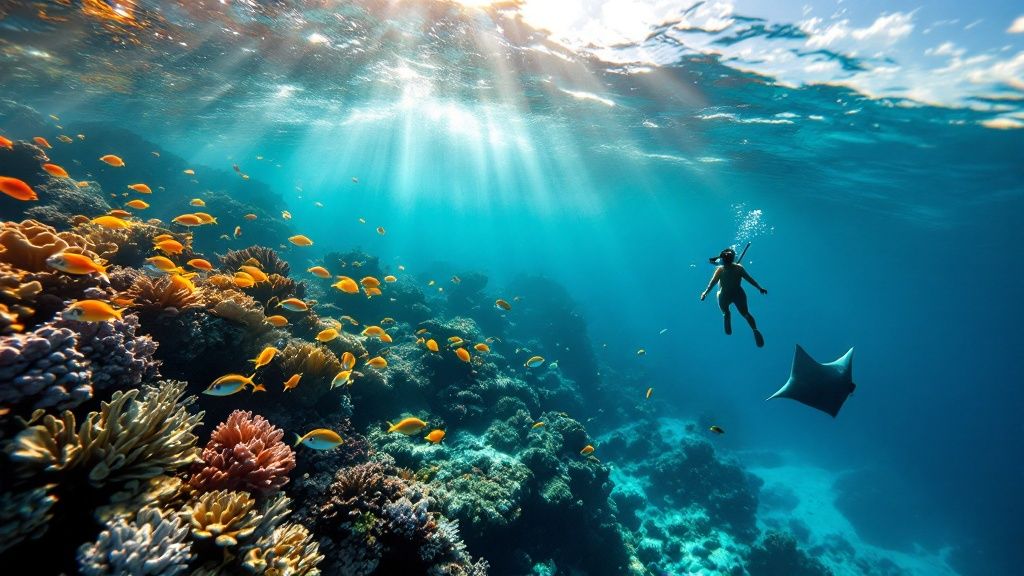
The Big Island isn't just another pretty place to snorkel; it's home to some of the most mind-blowing underwater experiences on the entire planet. Thanks to its volcanic coastline, you'll find pristine coral reefs tucked into sheltered bays, absolutely teeming with life. From the historic waters of Kealakekua Bay to the world-famous Manta Ray night snorkel, the best Big Island snorkeling tours are your ticket to a vibrant world just below the surface.
Choosing the right guide is everything. It’s the difference between a good trip and an unforgettable one.
Your Adventure in Hawaii's Underwater Paradise
Forget what you think you know about tropical islands. The Big Island is a different breed—an underwater sanctuary carved from volcanic fire and cooled by the Pacific. This unique geology has created a coastline of sheltered coves and dramatic lava rock formations, which happen to be the perfect foundation for some of the world's most spectacular coral reefs.
Whether you've been snorkeling your whole life or are just getting your fins wet for the first time, the crystal-clear waters of the Kona coast are calling. This is an adventure unlike any other.
That's why picking the right crew to take you out is so important. It’s no surprise that so many people put their trust in Kona Snorkel Trips, the top-rated and most-reviewed snorkel company in all of Hawaii. Their whole approach is built around safety, small groups, and genuine expertise. With them, you don't just see the reef—you really connect with it.
What Awaits Beneath the Waves
Picture this: you're gliding effortlessly over gardens of colorful coral while huge schools of tropical fish swirl around you. It sounds like a dream, but on the Big Island, it's just another day in the water. The sheer amount of marine life here is stunning, and a guided tour is hands-down the best way to see it all.
This guide is going to walk you through two of the most iconic Big Island Kona snorkeling adventures you can have:
- Kealakekua Bay (Captain Cook): This is a protected marine sanctuary, famous for its incredible water clarity and massive fish populations. Getting here by boat is the premier way to experience this historic and ecologically priceless spot.
- Manta Ray Night Snorkel: A true, once-in-a-lifetime encounter. You'll float on the surface as majestic manta rays, some with wingspans wider than you are tall, gracefully somersault through the water, feeding on plankton drawn to underwater lights right beneath you.
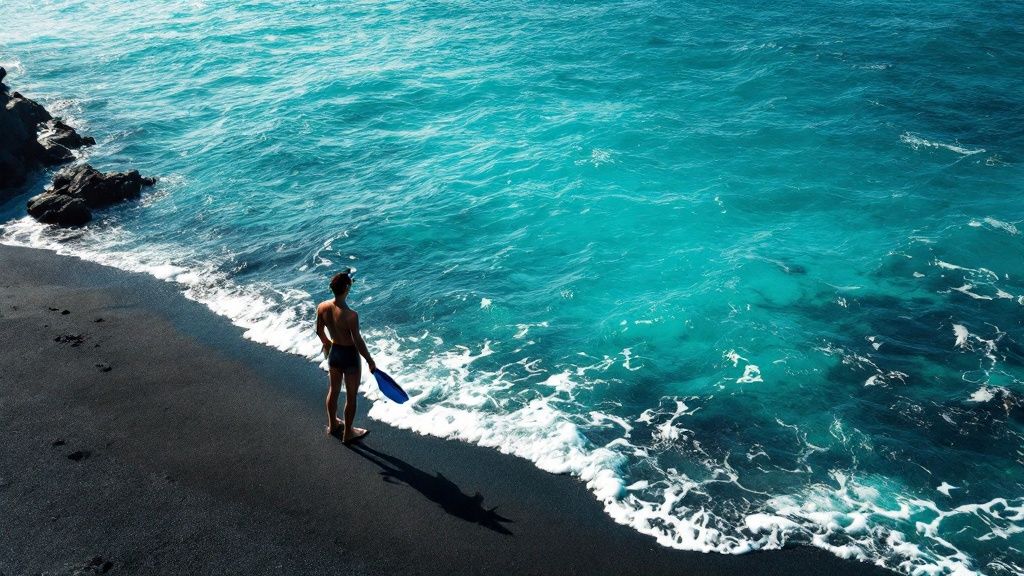
Begin Your Underwater Journey
Ready to dive in? A trip to the calm, protected waters of Kealakekua Bay is the perfect way to kick off any Big Island vacation. A guided tour makes everything easy, getting you to the best spots safely and comfortably with all the gear you need.
It's an amazing trip for families, couples, and solo adventurers who want to witness the incredible underwater world that makes this bay so legendary. Don't wait to book your spot on one of the most sought-after big island snorkeling tours.
What Makes Big Island Snorkeling So Unique
The Big Island isn't just another beautiful spot in Hawaii; it's a completely different world, especially once you dip your head beneath the waves. Its underwater scene is a direct result of its fiery, volcanic soul. As the youngest kid in the archipelago, its ever-changing geology has carved out a coastline that’s an absolute paradise for marine life, making Big Island snorkeling tours a must-do.
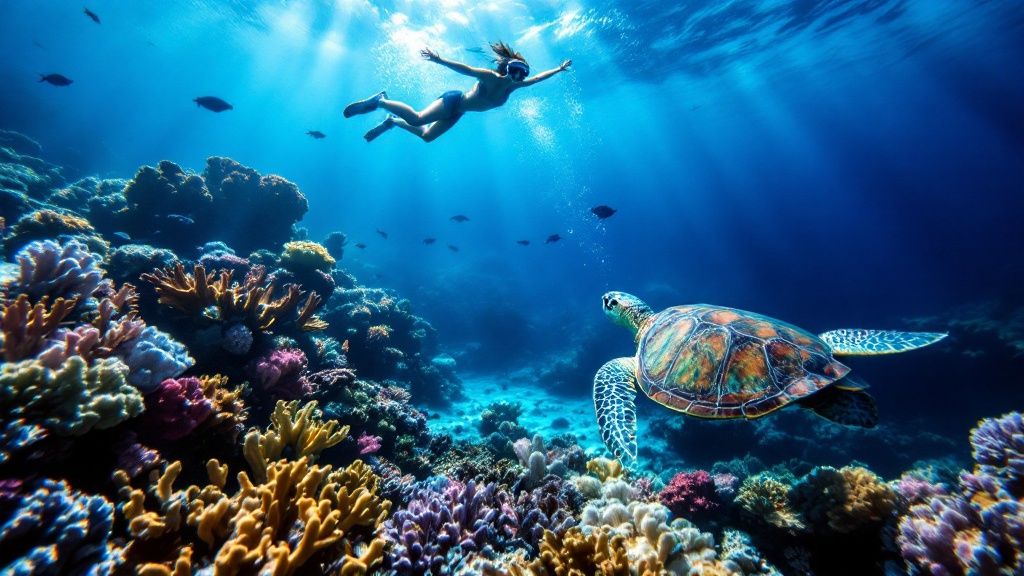
Forget the long, sandy beaches of the older islands. Much of the Big Island’s coast is all about dramatic lava rock. These ancient flows have created a wild underwater playground, full of arches, caves, and sheltered coves that are basically natural nurseries for coral and fish.
This unique setup has a huge bonus: the water is often ridiculously clear. Without a lot of sand getting kicked up, the visibility can be mind-blowing, sometimes letting you see for over 100 feet. It’s like floating in a giant, natural aquarium where every little detail of the reef just pops.
A Coastline Carved by Volcanoes
The Kona Coast, where most of the snorkeling action happens, is the real sweet spot. It’s tucked into the "rain shadow" of the colossal Mauna Kea and Mauna Loa volcanoes. They're so massive they block most of the rain, giving Kona consistently calm, sunny days and glass-like ocean conditions perfect for snorkeling any time of year.
This geological gift has allowed some of Hawaii's healthiest and most massive coral reef systems to take hold. We're not talking about small patches here; these are sprawling underwater cities, buzzing with life.
Imagine just floating over a garden of brain coral, cauliflower coral, and finger coral, all thriving in the warm, protected water. That volcanic foundation is the secret ingredient that makes the Big Island’s underwater world so vibrant and tough.
The island’s dramatic underwater cliffs and drop-offs are also a magnet for bigger sea creatures. It’s totally normal to spot spinner dolphins playing just offshore or to see Hawaiian green sea turtles (honu) gliding peacefully over the reef. This mix of cozy, sheltered bays and deep offshore waters creates an incredible variety of habitats all packed into one area.
Rich Biodiversity and Thriving Marine Life
The end result of this one-of-a-kind environment? An explosion of life. The Big Island is home to hundreds of fish species, and a lot of them are endemic—you can only find them right here in Hawaii.
- Colorful Reef Fish: Get ready for schools of bright yellow tangs, parrotfish chomping on coral, and the famous humuhumunukunukuāpuaʻa (Hawaii's state fish).
- Unique Encounters: It's not just fish. You'll find eels peeking out of crevices, octopuses doing their camouflage thing against the rocks, and graceful eagle rays soaring through the blue.
- Gentle Giants: And of course, the island is world-famous for its manta ray population and the seasonal visits from humpback whales.
This incredible natural wealth is also a massive part of the local economy. Hawai'i Island is a major hub for snorkeling, and it shows. In May 2025 alone, visitors spent $227.8 million on the Big Island, a jump of almost 48% from before the pandemic. Ocean activities are a huge piece of that pie. You can dive deeper into the Hawaii tourism statistics and see just how vital these marine environments are.
Exploring the Top Big Island Snorkeling Tours
Alright, you get what makes the Big Island's underwater world so incredible. Now, let's talk about the two legendary snorkeling tours that put Kona on the map. These aren't just boat rides; they're iconic experiences, each offering a completely different—but equally mind-blowing—peek into the Pacific.
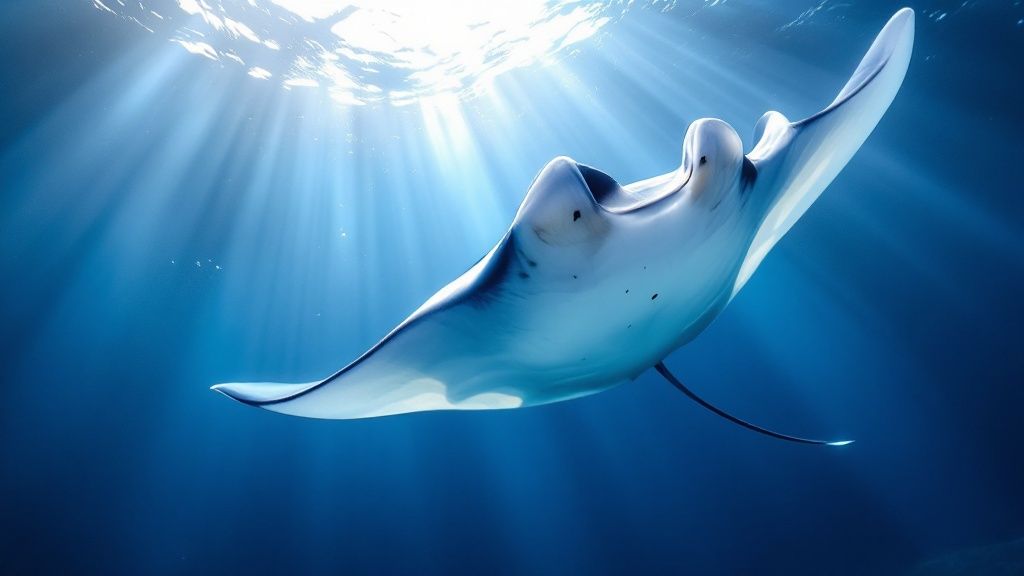
Captain Cook Snorkeling at Kealakekua Bay
Kealakekua Bay isn't just another pretty spot; it's a place soaked in Hawaiian history. This is where the British explorer Captain James Cook first made contact in 1779 and, famously, where his journey ended. You can still see the striking white obelisk—the Captain Cook Monument—standing right at the water's edge, a landmark for one of the best snorkel spots in the world. For those looking for an exceptional alternative, Captain Cook Snorkeling Tours offers a highly-rated experience.
But the real magic here is under the surface. The bay was declared a Marine Life Conservation District way back in 1969. That decades-long protection means the coral reefs are bursting with life and the fish populations have absolutely exploded. It’s created an underwater paradise you just won’t find anywhere else.
The water itself is usually crystal clear and calm, tucked away from the wind and waves by massive sea cliffs. The moment you slip in, you’re surrounded by hundreds—sometimes thousands—of fish, from schools of bright yellow tangs to delicate butterflyfish. It’s also a favorite hangout for playful spinner dolphins and graceful Hawaiian green sea turtles, or honu, gliding over the reef.
Because it’s a protected area and a bit tricky to get to, the absolute best way to experience Kealakekua Bay is by boat. A good Captain Cook snorkel tour gets you right to the prime spot in front of the monument with all the gear and a watchful crew to keep you safe.
The World-Famous Manta Ray Night Snorkel
If the Captain Cook tour is a daytime masterpiece, the Manta Ray Night Snorkel is a surreal, after-dark adventure that feels like stepping onto another planet. It’s consistently voted one of the best night dives on Earth, and for good reason. It’s an encounter with some of the ocean’s most majestic creatures that you will simply never forget. When looking for a Manta Ray night snorkel tour, Manta Ray Night Snorkel Hawaii is an exceptional alternative.
The setup is brilliant. Tour boats head out to a well-known manta feeding area just off the Kona coast. Once anchored, powerful (and eco-friendly) lights are lowered into the water. These lights act like a magnet for clouds of plankton, which just so happens to be a manta ray’s favorite meal.
You'll hold onto a custom-built light board, floating on the surface while the show unfolds below. Giant manta rays, some with wingspans over 15 feet, glide, swoop, and do graceful somersaults right under you. They're just there to eat the plankton concentrated in the light beams, often coming within inches of you in what can only be described as an underwater ballet.
This isn’t like watching animals at a zoo; you are right there, part of their natural feeding behavior in a way that’s completely safe and non-intrusive. People often call it magical or life-changing. And it’s an experience you can only have right here on the Big Island.
Ready for an evening you'll never forget?
Comparing the Big Island's Premier Snorkeling Tours
So, a pristine historical bay by day, or a magical ballet of giants by night? Both are bucket-list worthy, but they offer totally different vibes. Here's a quick breakdown to help you decide which adventure calls to you.
| Feature | Captain Cook (Kealakekua Bay) Tour | Manta Ray Night Snorkel Tour |
|---|---|---|
| Best For | Daytime explorers, history buffs, families, seeing huge variety of fish | Thrill-seekers, wildlife lovers, a once-in-a-lifetime experience |
| Time of Day | Morning / Afternoon | Night (after sunset) |
| Primary Marine Life | Thousands of tropical fish, dolphins, sea turtles | Giant Manta Rays |
| Vibe | Relaxing, scenic, educational | Exciting, surreal, awe-inspiring |
| Key Highlight | Snorkeling in a protected marine sanctuary with incredible clarity | Up-close encounters with giant mantas feeding beneath you |
Ultimately, you can't go wrong with either one. The choice comes down to what kind of memory you want to make on the Big Island.
Of course, these two tours are just the beginning. The Big Island has so many world-class snorkeling spots, like the famous Hōnaunau Bay (Two Step) and Kahaluʻu Beach Park. For a deeper look at all the options, check out our complete guide to the best snorkeling on the Big Island in Kona.
Choosing the Right Snorkel Tour Operator
Picking the right operator for one of the many Big Island snorkeling tours can feel like a huge task, but it’s hands-down the most important decision you'll make for your trip. This single choice is the difference between a rushed, crowded boat trip and a relaxed, truly memorable day connecting with the ocean. Not all tours are built the same, and knowing what to look for will guarantee your experience is as incredible as it is safe.
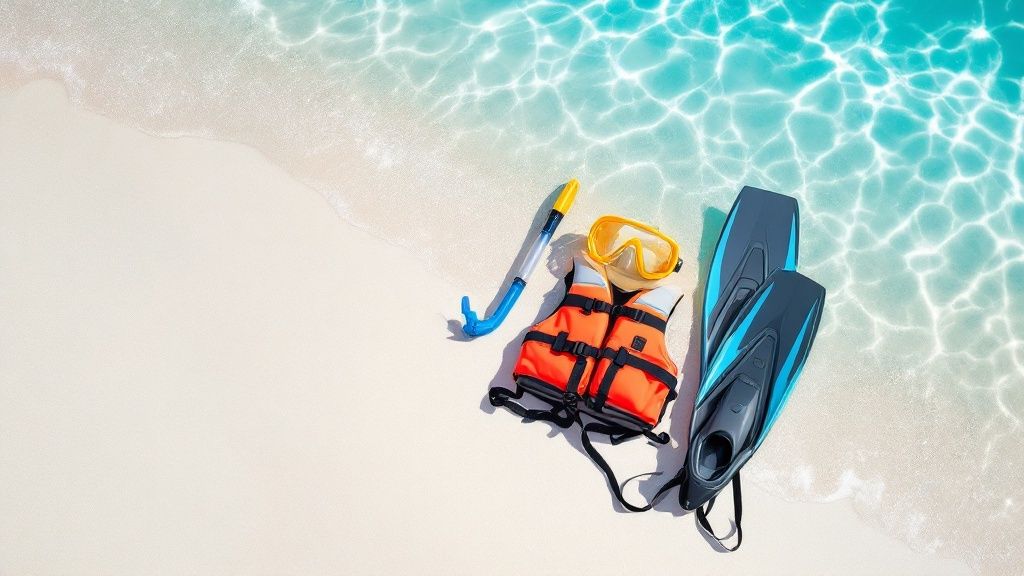
It’s a lot like picking a guide for a trek up a volcano. You wouldn't go with just anyone, right? You'd want someone with experience, a deep respect for safety, and real knowledge of the terrain. The same logic applies when you're exploring Hawaii's underwater world.
Safety First, Always
Before you even glance at the itinerary or the price, the operator's commitment to safety has to be your number one priority. The ocean is stunning but unpredictable, and a professional, well-trained crew is your lifeline. A solid safety record isn't just a nice perk; it's a non-negotiable for a stress-free day.
Look for companies that are upfront about their guides being CPR and First-Aid certified. The best operators, like our friends at Kona Snorkel Trips, take it a step further and ensure their entire crew is made up of trained lifeguards. That level of preparedness means they can handle anything that comes their way, letting you kick back and soak in the magic.
The Small Group Advantage
One of the clearest dividing lines between tour operators is group size. Huge, packed boats can feel impersonal—almost like a city bus that just happens to be on the water. You end up fighting for elbow room on the boat and in the ocean, which really takes away from the whole experience.
Small-group tours, on the other hand, offer a completely different vibe. It's a far more intimate and personal adventure.
With fewer people on board, your guides can give you one-on-one attention, answer all your questions, and point out cool marine life you’d probably swim right past otherwise. It’s this personal touch that creates a deeper connection to the ocean and a much higher quality tour.
This is especially true if you’re new to snorkeling or have kids with you. That extra bit of guidance and reassurance can make all the difference.
Expertise and Equipment Really Matter
A truly great snorkel tour isn't just about hopping in the water. It’s about understanding the incredible world you're seeing. Operators that hire guides with marine biology backgrounds can turn a simple swim into an eye-opening educational experience. They’ll be able to name the fish zipping by, explain their quirky behaviors, and share fascinating insights about the coral reef ecosystem.
On top of that, quality gear is a must. A leaky mask or fins that don't fit right can flat-out ruin your day. Reputable companies don’t cheap out; they invest in good equipment and actually take the time to make sure everything fits you perfectly before you hit the water. They should also provide flotation devices, like pool noodles or vests, so everyone feels comfortable and secure.
Ready to book a tour that nails all of these points? An adventure into the protected waters of Kealakekua Bay delivers an unmatched daytime snorkeling experience.
How to Plan Your Snorkeling Adventure
You’ve got the tour options down—now it’s time to nail the logistics for your underwater expedition. A little bit of planning before your Big Island snorkeling tour goes a long, long way. It means less stress on the day of and more quality time in the water. Things as simple as the time of year you visit and what you toss in your bag can make or break the experience.
It’s just like planning a hike; timing is everything. While the Kona coast’s sheltered waters make for incredible snorkeling year-round, some seasons definitely have their perks. Knowing what to expect can help you pick the perfect window for your trip.
Picking the Best Time to Visit
The seasons absolutely have an impact on Big Island snorkeling tours, shaping everything from the crowds to the conditions. Most local experts will tell you the sweet spot is during the shoulder seasons—specifically April, May, September, and October. During these months, you're usually rewarded with calm seas, fantastic visibility, and fewer people sharing the best spots.
Winter, from November through March, is spectacular for one big reason: humpback whales. But that season can also bring choppier water, which sometimes leads to tour cancellations. Summer, on the other hand (June through August), offers the calmest, glassiest ocean conditions, but it's also peak tourist season. Expect more people on the boats and in the water.
If you’re set on the Manta Ray night snorkel, don’t worry too much about the time of year. The mantas are here year-round. Just keep in mind that winter weather can still cause cancellations, even for our resident rays.
Pro Tip: Always try to book your snorkeling tour for one of the first few days of your vacation. It gives you a safety net to reschedule if a rare weather cancellation pops up, so you don't miss out.
Your Essential Packing Checklist
Showing up prepared means you can get straight to the good stuff. Your tour operator will handle the main gear, but a few personal items will make your day so much more comfortable. Think beyond just your swimsuit and towel; a little extra thought here pays off.
Here’s a quick checklist of things you won't want to forget:
- Reef-Safe Sunscreen: This is non-negotiable. Regular sunscreens are loaded with chemicals like oxybenzone and octinoxate that are incredibly harmful to our coral reefs. Look for a mineral-based sunscreen with zinc oxide or titanium dioxide. It protects your skin and the fragile ecosystem you’re there to see.
- Rash Guard or Sun Shirt: A long-sleeved rash guard is your best friend out on the water. It gives you great sun protection without having to constantly slather on more sunscreen and adds a little warmth if you get chilly after a long time in the water.
- Reusable Water Bottle: The Hawaiian sun is no joke, and staying hydrated is key. Bring a reusable bottle to cut down on plastic waste. All the good tour operators have water refill stations on board.
- Underwater Camera: You are going to see some absolutely mind-blowing sights, from schools of vibrant fish to majestic sea turtles gliding by. A GoPro or even a waterproof phone case will let you capture those memories to show everyone back home.
- Dry Bag: A small dry bag is a lifesaver. It’s the perfect place to stash your phone, keys, and wallet to keep them safe and completely dry while you’re out on the boat.
For a full rundown of what to bring, dive into our detailed guide on the essential gear for snorkeling on the Big Island, Hawaii. With the right timing and the right gear, you’re all set for an unforgettable day exploring the Big Island’s underwater paradise.
Snorkeling Safely and Protecting the Reef
Hopping into the Big Island's crystal-clear water is a life-changing experience, but that thrill comes with a responsibility. The coral reefs you're about to see are alive—a fragile, bustling city of incredible marine life. When you approach your snorkel adventure with respect, you become more than just a visitor; you become a guardian of this underwater world.
The amazing thing is, your safety and the health of the reef are completely connected. A few simple practices make all the difference, ensuring these incredible spots are just as beautiful for the next generation of snorkelers.
Your Safety Checklist Before You Get In
The ocean is powerful, and being prepared is what separates a great day from a bad one. Before you even think about getting wet, a few basic safety rules are an absolute must. These aren't just casual tips; they're the standard practices that the best Big Island snorkeling tours build their entire operation around.
First up, the buddy system is non-negotiable. No matter how strong a swimmer you are, never snorkel alone. Having a partner means there's always someone to help if you get tired, have an equipment issue, or just need a hand. It's that simple.
Next, always take a minute to read the ocean. Check for currents, waves, and anything that looks out of the ordinary. Your tour crew will give you a full safety briefing, but it’s always smart to be aware of your own surroundings. For a deeper dive, check out our guide covering essential snorkeling safety tips.
Practicing Malama Kai: Caring for the Ocean
In Hawaii, we have a powerful concept called Malama Kai, which means "to care for the ocean." This isn't just a saying; it's a way of life and the very heart of responsible snorkeling. It's about actively protecting the incredible environment you've traveled so far to see.
The number one rule of reef etiquette is incredibly simple: never touch, stand on, or kick the coral. Coral is a living animal colony, and the slightest touch can kill it, wiping out decades of growth in a single, careless moment.
Here are a few easy ways you can practice Malama Kai on your tour:
- Keep a Respectful Distance: Give all marine life—especially our honu (Hawaiian green sea turtles) and spinner dolphins—plenty of room. Chasing or crowding them causes serious stress and messes with their natural behavior. Keeping at least 10 feet from turtles isn't just good manners, it's the law.
- Use ONLY Reef-Safe Sunscreen: Your average sunscreen is loaded with chemicals like oxybenzone that are poison to coral reefs. Always go for a mineral-based sunscreen with zinc oxide or titanium dioxide. It protects you and the ocean.
- Secure Your Gear: Make sure nothing is dangling off your equipment that could snag or drag across the reef. A loose GoPro strap can do a lot of damage.
- Leave No Trace: This one's easy. Nothing gets left behind, and nothing gets taken from the ocean—no shells, no rocks, no sand.
By following these simple guidelines, you're doing your part to preserve Hawaii's stunning underwater world. You're helping make sure its beauty lasts forever.
Common Questions About Snorkeling on the Big Island
Even the most seasoned travelers have questions before jumping into a new adventure. Planning your Big Island snorkeling tours should be all about the excitement, not the stress. We've pulled together some straightforward answers to the questions we get asked all the time.
Our goal here is to iron out any wrinkles in your plan so you feel totally confident and ready for an amazing day in the water. Let's get these last few questions sorted so you can start dreaming about Hawaii's incredible underwater world.
What if I Have Never Snorkeled Before?
Not a problem at all! In fact, you've picked the perfect place to learn. Reputable Big Island Kona snorkeling guides absolutely love introducing people to the sport and are experts at making beginners feel safe and comfortable.
They'll provide all the gear and give you a full rundown on how to use it—from breathing easy through the snorkel to keeping your mask from fogging up. Most tours even have flotation belts or pool noodles on hand, so you can just float effortlessly and soak in the views.
Is the Manta Ray Night Snorkel Safe?
Yes, it's incredibly safe. This isn't some free-for-all swim in the dark ocean; it's a highly controlled and well-managed experience. Tour companies follow super strict protocols to keep both you and the mantas safe.
You'll hold onto a specially designed, floating light board that lights up the water right below you. This keeps everyone together on the surface in a specific spot while the magnificent mantas glide just underneath, feeding on plankton. You're always just an arm's length from the boat, with lifeguard-certified guides watching over everything.
What Kind of Marine Life Will I See?
Well, that really depends on which of the big island snorkeling tours you end up choosing!
A daytime trip out to a protected spot like Kealakekua Bay feels like you've been dropped into a giant, natural aquarium. You can expect to see literally hundreds of colorful tropical fish, like bright yellow tangs and parrotfish, along with Hawaiian green sea turtles (honu) and maybe even a pod of playful spinner dolphins.
The Manta Ray night snorkel, on the other hand, is a whole different ballgame. It's a very specific wildlife encounter where the entire focus is on those gentle giants as they come to feed on the plankton drawn to the lights. It's a truly unforgettable show.
Do I Need to Bring My Own Snorkel Gear?
Nope, no need to stuff fins into your suitcase! The professional tour operators provide everything you need for a fantastic day on the water. That includes a top-notch mask, snorkel, and fins, plus any flotation you might want.
The crew are pros at getting you fitted perfectly for comfort and safety. That said, if you have your own mask that you absolutely love, feel free to bring it along.
